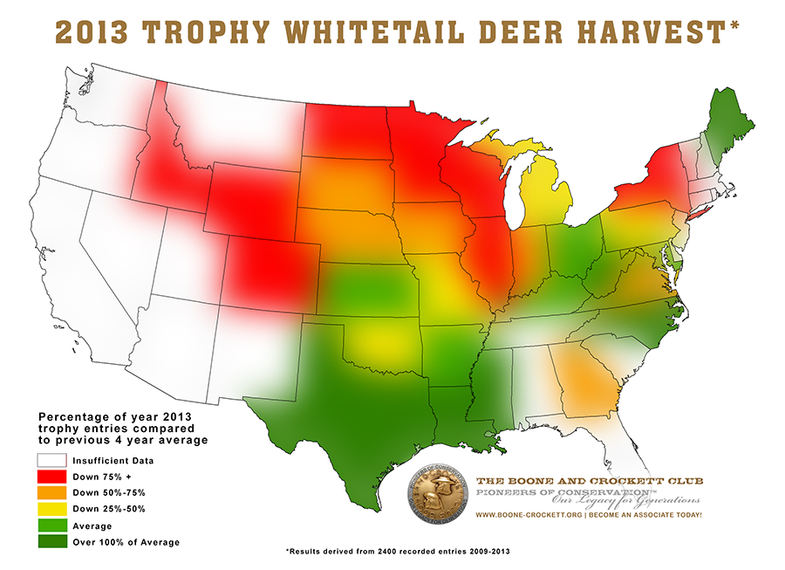B&C Whitetail Entries Plummet—But It’s Not All Bad
As many hunters have surely noticed, the trophy whitetail bubble appears to have burst, according to research produced by the...

As many hunters have surely noticed, the trophy whitetail bubble appears to have burst, according to research produced by the Boone and Crockett Club. Assistant director of records Justin Spring recently produced a national map that shows a steep drop in B&C entries, particularly in perennial big-buck states like Illinois and Wisconsin.
Spring, like many of us, has heard a lot of talk about a “crash” in whitetail numbers in top states over the last couple of years. “So I decided to see if entries in our record books reflected that trend,” he told me. “Even I was surprised by the drop we saw in some of the states.”
To make the map, Spring compiled B&C whitetail entries—which must score a minimum of 170 inches—from the 2013 hunting season (2014 is not included, because entries for last season will likely keep rolling in until this fall) and compared them to the average number of entries over the previous five years (2008-2012). As noted in the color-coded chart accompanying this map, states like Illinois, Wisconsin, Minnesota, and New York have fallen at least 75 percent below the previous average. Several other perennial B&C producers, including Iowa, Missouri, and Nebraska are also way down.
The reason for the drop? “I’ve shared this with several whitetail groups, and they all seem to pick their favorite poison,” Spring says. “EHD has definitely taken a toll, hard winters have been a factor, several states have significantly—and intentionally—reduced their herds. I doubt it’s any one factor. To me, the main message is that we were probably at, or over, carrying capacity across much of whitetail habitat. And when that happens, something has to give; either we take care of it, or Nature does.”
That said, the picture is not all doom-and-gloom. “Texas surprised me,” Spring notes. “With the rise of high-fence hunting there, I thought the number of fair-chase entries from there might drop, but it didn’t. Louisiana and Mississippi continue to be strong, as are Ohio, Kentucky, and Maine.” States marked in white simply had insufficient data for Spring to include in the analysis. “Typically they are states that don’t enter a lot of bucks, and if for some reason they had a down year and zero entries, I didn’t want to include them as indicative of a trend.”
You can’t look at this map without concluding that big-buck numbers are way down. But Spring believes there’s a silver lining: “There are places where the deer herd is down significantly, and hunters are no doubt frustrated,” he said. “But rebuilding herds typically produce bigger bucks, as there is less social stress and competition for food and habitat. When you look at some of the great bucks taken throughout our history, many of them came from places with low deer populations. The next few seasons could produce some truly giant whitetails.”
